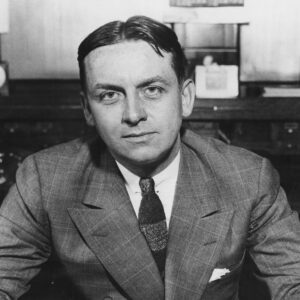Poliomyelitis is a “highly contagious viral infection that can lead to paralysis, respiratory problems, and even death caused by the poliovirus.”1 The virus is highly contagious and specific to humans. The first outbreak of polio in the United States occurred in 1894 with more than 132 reported cases. The number of infected people throughout the United States increased rapidly after the first epidemic with thousands being affected every year after the first onset.2 Thousands of people in the United States were affected by the virus before Dr. Jonas Salk found the vaccine for Poliomyelitis.
Dr. Jonas Salk was born on October 28, 1914, just as World War I was beginning, and four years before the great influenza pandemic of 1918-1919. In 1916 influenza and polio began killing children and the elderly in large numbers.3 Salk’s brilliance could be seen at a young age. When he began school at the age of five, he was very eager to learn, and was able to skip ahead a few grades. Salk described his early years as “the life of an only child, having full attention of a doting, controlling mother who wanted to be sure that her child is protected and will grow up to be a worthwhile person.”4 Salk’s mother could not have done a better job. Dr. Jonas Salk began conducting research on viruses in the 1930s as a student at New York University. After graduating from New York University, Salk attended the University of Michigan. At the University of Michigan, Dr. Salk began working on a flu vaccine, for which he is now known as one of the key contributors to the development of the flu vaccine during World War II. By the 1950s, he was awarded a grant to “study the polio virus and develop a possible vaccine.”5 Dr. Salk had devised a version of the polio vaccine immediately after obtaining the grant. He began clinical trials in which he “was to kill several strains of the virus and then inject the benign viruses into a healthy person’s bloodstream.” 6 This was attempted at first by various other scientists before it was perfected by Dr. Salk. This was successful because the person’s immune system in which it was injected would soon begin to form antibodies towards the virus, which would help in resistance with future exposure to polio.
Before the vaccine was developed and made widely available to the public, many researchers developed alternative ways to help control the symptoms of polio. Sister Kenny, an Australian nurse, came to the United States to promote a treatment she had developed specifically for polio. This treatment consisted of the use of warm compresses to relax contracting muscles. Another invention was that of the “iron lung,” which was developed to aid in respiration. Some of the main symptoms of polio are swallowing and respiratory difficulties, so the “iron lung” was developed to help alleviate some of the respiratory problems people with polio were experiencing.7

On March 26, 1953, Dr. Salk was able to announce his findings on the polio vaccine. The news was quickly published in articles and newspapers and announced on the radio. In 1954, clinical trials began testing on approximately two million American schoolchildren. It was not until April of 1955 that it was announced that the vaccine was indeed effective and could be manufactured. It took about two years for the vaccine to become widely available throughout the United States. Within the first year that the polio vaccine became available the number of cases per year decreased dramatically. Polio, along with many other viral diseases, has no cure. The vaccine that was manufactured was intended to prevent others from contracting the virus. With polio, prevention is the key. Albert Sabin, a Polish-American researcher, was able to facilitate the distribution of the vaccine by developing an oral vaccine.8
For the current year 2016, only about seventy cases of poliomyelitis have been reported, and only two countries remain polio-endemic.9 About 90-95% of the reported cases are asymptomatic, meaning no symptoms are present. This has been made possible because of Dr. Salk and all of the researchers that put their time and effort into discovering the vaccine to prevent poliomyelitis.
- Bernard Seytre and Mary M. Shaffer, “Coming Along at the Right Time: Jonas Salk,” in The Death of a Disease : A History of the Eradication of Poliomyelitis (New Brunswick: Rutgers University Press, 2005), 44. ↵
- Scott S. Smith, “Jonas Salk Stood Tall With His Polio Vaccine Rescue: The Chemist Came through in Paralysis Battle,” Investor’s Business Daily, July 17, 2015. ↵
- Scott S Smith, “Jonas Salk Stood Tall With His Polio Vaccine Rescue: The Chemist Came through in Paralysis Battle,” Investor’s Business Daily, July 17, 2015. ↵
- Charlotte DeCroes Jacobs, Jonas Salk: A Life, 1st edition (Oxford ; New York: Oxford University Press, 2015), 36. ↵
- Scott S. Smith, “Jonas Salk Stood Tall With His Polio Vaccine Rescue: The Chemist Came through in Paralysis Battle,” Investor’s Business Daily, July 17, 2015. ↵
- Salem Press Biographical Encyclopedia, 2015, s.v. “Jonas Salk,” by Elof Axel Carlson. ↵
- Charlotte DeCroes Jacobs, Jonas Salk: A Life, 1st edition (Oxford ; New York: Oxford University Press, 2015), 45. ↵
- Salem Press Biographical Encyclopedia, 2015, s.v. “Jonas Salk,” by Elof Axel Carlson. ↵
- Seytre and Shaffer, “Coming Along at the Right Time: Jonas Salk,” in The Death of a Disease : A History of the Eradication of Poliomyelitis, 44. ↵



65 comments
Lianna Ybarra
Great article! I found it very informative on the history of how the vaccine came to be found.I didn’t know that there were other methods such as the iron lung as something to help with the symptoms of polio. One of my relatives actually has the disease, so it was interesting being able to put the history behind it. I am glad that not as many people have to experience polio anymore. Thanks to the work of Dr. Salk, our world has drastically lowered the amount of polio cases and we are still preventing it to this day.
Priscilla Reyes
How awesome! Dr. Salk was able to come up with a vaccine in a short amount of time and at a very young age. I thought it crazy how the vaccine was tested on school children. My guess behind this is that the youth is able to recover quickly, had anything gone wrong, rather than an older person. Great job!
Cameron Adelman
Great job. You did exceptionally well with the organization of this article, creating a natural flow from beginning to end. It made the article easy to follow and enjoyable to read. The only feedback that I have for you is that the third paragraph seems oddly out of place in this article, not necessarily irrelevant, but not as important in the grand scheme of the piece. The article would likely read even cleaner than it does now if you removed that particular paragraph.
Yesenia Cardenas
Great job with this article. As bad as polio was, I am glad that doctors were able to greatly reduce its harm to so many people. It still scares me though how recent polio was a major problem as some older adults have memories of it.
Christian Lozano
Great Article! Thank God for Dr. Jonas Salk and his hard work in finding a cure for Polio. Having a vaccine created from his research must have been an astounding feeling and accomplishment for him, as he would not only help the sick ones of his day, but many years into the future people would still reap the benefits.
Salvador Rodriguez Gomez
Amazing read! This guy did amazing work and you did a great job of presenting this information on polio and his efforts to create the vaccine. Health must have been a really big concern back then and thanks to Dr. Salk many families were saved from the virus and we don’t have to worry about it today.
Nicolas McKay
My grandfather has told me stories of the horror of Polio, the friends and family that it killed. I knew they had found a vaccine for it, but I had never known who. This man truly saved many lives, and no doubt laid down the foundation for vaccines and modern medicine.
George Manzanares
Wow! Amazing! More often than not, we look at our modern society and take many things for granted. People complain about having to drive in traffic. They complain about having to type a paper. Yet, innovations have made it possible to travel faster and write more efficiently! Similarly, innovations in medicine has put us ahead of the curve. We are lucky and blessed to be able to be safe from such horrific diseases. Well done on illustrating the work of Dr. Salk and many others!
Aaron Jaramillo
Great article. With still so much conterversary about getting children vaccinated, after reading this article I believe parents should vaccinate their children. I also found the “iron lung” that was invented rather interesting. I wonder is that concept is still utilized in today’s medicine. Good information on polio.
Kassandra Guillen
Over the years I have been given very basic information about Dr. Salk and his contribution to treating polio, but this article provided me with a more in depth understanding. This article provided information on a very deserving topic, for polio had a huge impact on the lives of many in the United States during this time. I will be ever grateful for those who put much of their time and effort into advancing medicine for the common good. Thank you for sharing this information!